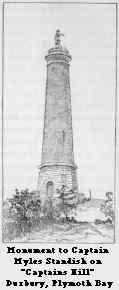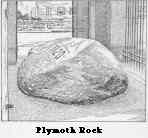Resource Center OLLibrary
|
68 |
|
[1620 |
could have no peace, but were "hunted," "persecuted," and
"clapped up in prison." For this reason they fled to Holland
(1607), where, they had heard, there "was freedom of religion for
all men."
69. The Separatists, or Pilgrims, resolve to
go to America; their Reasons. At length a part of the
Separatists, or Pilgrims1, as they now with good
reasons called themselves, -- for they had no fixed home, --
resolved to emigrate to America.
Three chief reasons induced the Pilgrims to
leave Holland:
1. Though they were with a friendly people, yet
they were among those whose language and customs were not
English.
2. As their children grew up, they would
naturally marry into the Dutch families, so that in a few
generations their descendants would become Dutch.
3. Finally, they desired to build up a community
on soil belonging to England, where they and those who came after
them might enjoy both political and religious liberty, according
to the Pilgrim standard of what was just and right.
70. Where they proposed going; how they got
Assistance to go. The only English settlement then in America
was that at Jamestown, Virginia (§ 46). The Pilgrims could
not go to that part of the country, for no worship but that of the
Church of England was permitted there. They finally obtained from
the London Company (§§ 43, 45) the right to settle at
some place near the Hudson River.
A company of English merchants and speculators
agreed to help them on these hard conditions:
1. The Pilgrims were to work for seven years
without a single day to themselves except Sunday.
2. At the end of that time all the property they
had accumulated was to be divided equally between them and the
company of merchants.
1 "So they left that
goodly and pleasant city [Leyden, Holland (Map, p. 67)]
which had been their resting place near twelve years; but they
knew they were PlLGRIMS [see Hebrews xi. 13] and looked
not much on those things; but lifted up their eyes to the heavens,
their dearest country, and quieted their spirits." --
BRADFORD'S
History of Plymouth, 1607-1646. Bradford's MS. is preserved
in the State Library in the Statehouse, Boston.
|
1620] |
|
69 |
71. The Pilgrims sail; Myles Standish.
The Pilgrims went over from Holland to England, and in the autumn
of 1620 the Mayflower sailed from Plymouth, carrying the
second English colony that was to make a permanent home in the New
World (§ 46). There were only 102 of the emigrants, and of
these less than ninety could be called Pilgrims. The others were
persons who had joined them, or were servants or sailors.
Among those who were not members of the Pilgrim
congregation, but who chose to go with them, was Captain Myles
Standish. He was a man with the heart of a lion in battle, and the
hand of a woman for the sick and wounded. Without his counsel and
his sword it is doubtful if the colony could have succeeded.
72. The Pilgrims reach Cape Cod; the
Compact. On a morning late in November (1620) the storm-tossed
Pilgrims sighted Cape Cod. They tried to go south of it, in order
to reach the vicinity of the Hudson River (§ 70), but the
weather was against them. Two days later (November 21), the
Mayflower came to anchor in what is now Provincetown
harbor, at the extreme end of the Cape.
The Pilgrims had no authority to settle in New
England, but they decided to do so. Some of their hired men now
declared that they were free and would do what they pleased.
Hearing that threat, the Pilgrims gathered in the cabin of the
Mayflower and drew up and signed a compact or agreement. In
that compact they declared themselves "loyal subjects" of the
King. At the same time they declared that they were resolved to
make whatever laws might be needful for the "general good of the
colony." They then elected John Carver for their first governor.
Thus the new commonwealth began; they were but a few score people,
but they had the strength that belongs to those who fear God and
respect themselves.
73. They explore the Coast, and land;
Plymouth Rock; the First Winter. While the Mayflower
remained at anchor Captain Standish with a boat load of men went
out to explore. On December 21 they reached the harbor which
Captain John Smith had called Plymouth on a map which he made when
in Virginia (§ 48).
|
70 |
|
[1620-1621 |
|
On the shore of that harbor lies a
part of a granite bowlder. (sic) It is said to be the
only one directly on the water's edge for several miles.
According to tradition they landed on that bowlder. It is
only a few feet square, but Plymouth Rock fills a greater
place in |
|
1626-1630 ] |
|
71 |
|
skin. The Governor took the snake skin, stuffed it
full of powder and bullets, and sent it back. Canonicus
looked at it, felt of it, and then said, "We had better
let the Governor alone." When trouble with the Indians
did arise later, Myles Standish 71) soon made them
confess that though "he was a little man, he was a great
captain." |
 |
|
72 |
|
[1630 |
IV. MASSACHUSETTS (MASSACHUSETTS BAY COLONY, 1630)
76. Settlement of Salem; Governor
Endicott; Toleration. A number of years after the Pilgrims
landed at Plymouth, the Massachusetts Bay Company1 in
England sent out John Endicott to take charge of a small colony at
Salem (1628).
Governor Endicott was a strict Puritan
(§§ 53, 67). He lived in an age when the toleration of
religious liberty was unknown in Great Britain. If he had found
"toleration" in his dictionary, he would have cut the word out,
just as he drew his sword and cut the red cross out of the English
flag because it represented the ancient Catholic faith of
England.
77. The Great Puritan Emigration; Winthrop's
Colony; Settlement of Boston, 1630. But the great emigration
to New England began in 1630. The royal charter gave the
Massachusetts Bay Company the territory extending along the coast
from the Charles River to the Merrimac. Westward it extended, like
Virginia (§ 43), to the Pacific.
The Company appointed John Winthrop,2
a wealthy Puritan, governor. He came, bringing the charter with
him, and a colony of over 700 persons with horses and cattle.
The colonists named the place where they finally
settled, Boston, because of their affectionate remembrance of the
ancient city of Boston, England. (Map, p. 67.)
In the course of the next ten years more than
20,000 of Governor Winthrop's countrymen came to New England.
Among them were highborn men and women, with graduates of Oxford
and Cambridge, besides people of property and influence, the very
flower of the English Puritans."
1 The Plymouth
Company of England which had never succeeded in planting a
permanent colony (§§ 43, 45) was reorganized in 1620
under the name of the Council for New England. In 1627-1628 this
Council issued a grant to the Massachusetts Bay Company which was
confirmed by a royal charter.
2 Governor Winthrop of Groton,
Suffolk County, in the east of England. He came for the same
reason that Endicott did, because the Puritans, as he said, had
"no place to fly unto but the wilderness." He also felt that Great
Britain needed an outlet for her unemployed thousands. "This land"
(England], said he, "grows weary of her inhabitants, so as
man, who is the most precious of all creatures, is here more vile
and base than the earth we tread upon, and of less price among us
than a horse or sheep." --
WINTHROP'S Life
and Letters.
|
1634 ] |
|
73 |
78. How Massachusetts was governed; Town
Meetings; who could vote; Occupations of the People. At first
all the public affairs of the colony were managed by a council.
Later (1634), the towns sent representatives to the Legislature to
make the laws.
In all cases the towns managed their own local
business, such as the making of roads and the care of schools, in
town meeting as the Pilgrims at Plymouth did (§ 74).
Thomas Jefferson of Virginia lamented that his
colony did not do the same. He said the New England town meetings
had proved themselves the "wisest invention ever devised by the
wit of man for the perfect exercise of self-government."
We have seen that in Virginia (§§ 51,
53) the right to vote on colonial matters was finally restricted
to men of property; in Massachusetts it was confined to members of
the Puritan church. The Virginians wished to keep the government
of their colony in the hands of the royalist landholders or
responsible citizens; the Puritan commonwealth of Massachusetts
wished to keep theirs under the control of Puritans. This corner
of the continent, said they, is ours. If others come to it who
want a different religion and different kind of government, we
give them full liberty -- to move on.
Governor Winthrop, like Governor Berkeley of
Virginia (§ 53), wanted a state governed not by the majority,
but by a select few. "The best part of a community," said he, "is
always the least, and of that part the wiser are still less."
In Massachusetts much of the soil was poor; the
farms were small, and there were no great plantations like those
of Virginia. A large number of the people were engaged in the cod
fisheries on the banks of Newfoundland, and many were employed in
the construction of vessels. Boston had some of the best
shipbuilders in the world. It had also a thriving commerce with
the West Indies. The colonists sent out cargoes of staves and
lumber, and imported quantities of sugar and molasses from which
they distilled the famous "New England rum," an article which
people then believed to be one of the necessaries of life.
 the
history of our country than any other single stone on the
American continent.
the
history of our country than any other single stone on the
American continent.


